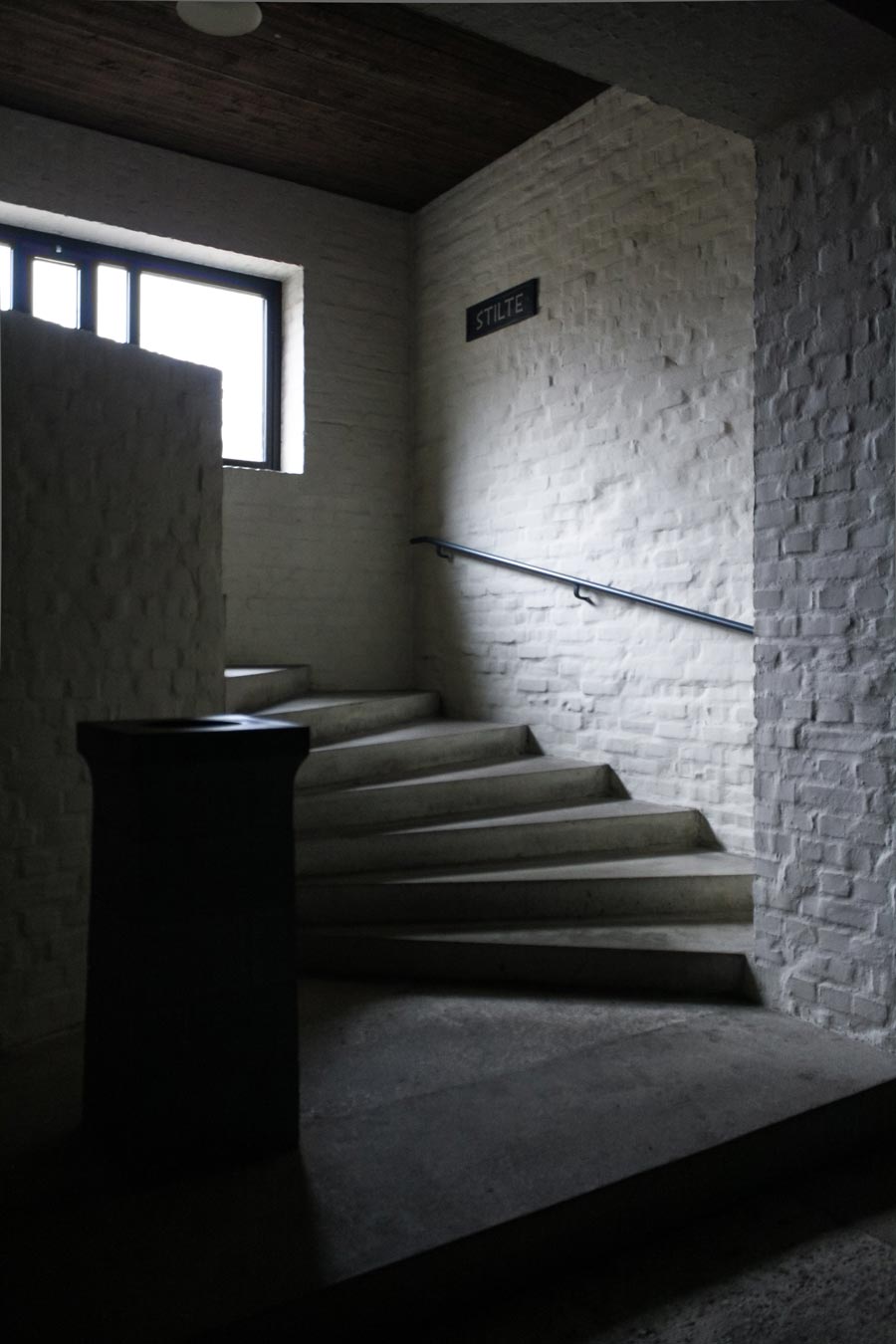-
The Rule
of HoursAbdij Sint Benedictusberg
By James Marriott
-

Artist and activist James Marriott reflects upon the acts of communing undertaken by an order of Benedictine brothers, and how they are shaped by a monastery designed by the architect and monk Hans van der Laan.
The Abdij Sint Benedictusberg is a community of Benedictine monks that was established in an abandoned monastery near Maastricht in 1951. The abbey is utterly focused on the life of prayer, expressed through eight daily services – the Hours – in which the psalms are sung, starting at five o’clock in the morning and ending at nine o’clock in the evening.
The abbey, like all Benedictine houses, strives to keep as close as it can to the Rule of St. Benedict, a book of precepts written in about 540 AD by St. Benedict of Nursia that has been continually observed in monasteries ever since. The Rule precisely describes an ideal Christian community as seen by a man living at the point of transition between the Classical World and the Medieval World. For guidance, St. Benedict looked to the communities of the Early Christian Church, as portrayed in the Acts of the Apostles written nearly four centuries earlier. Consequently, the monks at Sint Benedictusberg today try to live up to a vision of community that is two thousand years old. They orient their imaginations towards an idealised vision of Christ created by those who followed soon after him.All photos: Flickr/ Jason John Paul Haskins (CC BY-NC-SA 2.0)
-
»In the most remarkable way, light becomes solid matter as it falls into the silent rooms and passageways.«
-
The sense of this unchanging continuity is emphasised by the language in which the community expresses its central activity. Despite being located in the Netherlands, where all the monks speak Dutch, almost the entirety of the daily services is sung in Latin. Similarly, the reading given to the brothers as they eat their midday and evening meals in silence is partly in Latin. This language, in which the Medieval Church expressed itself, is a foundation stone of the shelter that the monastery provides for those that live there. The monks learn Latin upon joining the monastery, and through it they give order to their world.
Sint Benedictusberg is famed for its architecture. Most of it was built between the 1960s and 1980s, designed by the architect Hans Van der Laan – who throughout that period was a brother in the abbey itself. The simplicity of its form, with square windows and unadorned pillars, is heightened by uniform grey paintwork and a grey skim of cement on all the internal walls. Every piece of furniture – tables, chairs, pews and beds – was built from wood in the abbey workshop according to Van der Laan’s designs. His style gives each object a heavy solidity, which echoes the structure of the buildings. In the most remarkable way, light becomes solid matter as it falls into the silent rooms and passageways. In a place where there are so few objects, the material quality of the world is acutely highlighted.
-
»Life in the abbey is like living in a human clock.«
-
The consistency of the aesthetic serves to emphasise the distinctness of each type of space: the cells, the chapel, the refectory and the cloister. St. Benedict’s Rule demands that spaces within the monastery should be precisely delineated, and that the distinct activities of the day are to take place in the correlating distinct spaces within the abbey. Monasteries have therefore long been constructed on similar ground plans. Van der Laan’s designs honour these Romanesque foundations and bring to bear on them the experience of modernism. As a result, the building feels extremely ancient and yet somehow encompasses the experience of Europe’s catastrophic twentieth century.
The distinctness of spaces is emphasised by the way in which they are used at different times of day: the chapel for the eight services, the crypt for private prayer, the cloister for evening recreation. Again, the exact rhythm of the abbey follows closely from The Rule, in which St. Benedict fearsomely describes the punishments that should be meted out to any brother who is late for a service or a meal. Life in the abbey is like living in a human clock; the rituals of singing, eating and sleeping mark out the passing of time. These rituals are repeated day after day, week after week, as the monks sing their way through all 150 Psalms every seven days. Part of the function of the community is to mark out God’s time, to mark out the years through which each of the brothers live. The sense of the passing of days is emphasised by the movement of light around the chapel, the bells that are rung at Laudes and at Vespers, and the graveyard just beyond the cloister.
Patrick Leigh Fermor, following his first visit to an abbey, wrote in 1957: “Only by living for a while in a monastery can one quite grasp the staggering difference from the ordinary life that we lead. The two ways of life do not share a single attribute, and the thoughts, ambitions, sounds, light, time and mood that surround the inhabitants of a cloister are not only unlike anything to which one is accustomed, but in some curious way seem its exact reverse.” -
James Marriott is an artist, activist and naturalist and works as part of Platform. This collective, based in London but working with allies internationally, combines artists, educators, activists and researchers who work to assist social and ecological justice. Founded in 1983, Platform has had a particular focus since the mid-1990s on global oil and gas corporations, campaigning against its impacts on the climate, as well as human rights, the environment and democracy. Marriott’s most recent book, co-authored with Mika Minio-Paluello, is The Oil Road: Journeys from the Caspian to the City of London (Verso 2012).
A longer version of this article first appeared on Platform on Oct 22, 2014 under the title: A journey to ‘communities of the ideal’.
It is a truism to say, as many of us do, that there are not enough hours in the day to complete the tasks that one’s everyday work demands. Of course a sense of being busy is common to all walks of life – even the abbot at Sint Benedictusberg told me that the previous months had been hectic. But whereas life in the abbey on one day, one week, or one year will be more or less as it is the next day, next week, or next year, my life in the city seems to become increasingly hectic. The future is always expanding, and with it the workload. Meanwhile, the definition of what is “work time” and what is “non-work time” is constantly being altered by technology, and workers are required to be “flexible”, or rather available for work well beyond working hours.
The problem is the distinctness of Time, for those of us not living in monasteries, is being eroded.

-
Search
-
FIND PRODUCTS
PRODUCT GROUP
- Building Materials
- Building Panels
- Building technology
- Façade
- Fittings
- Heating, Cooling, Ventilation
- Interior
- Roof
- Sanitary facilities
MANUFACTURER
- 3A Composites
- Alape
- Armstrong
- Caparol
- Eternit
- FSB
- Gira
- Hagemeister
- JUNG
- Kaldewei
- Lamberts
- Leicht
- Solarlux
- Steininger Designers
- Stiebel Eltron
- Velux
- Warema
- Wilkhahn
-
Follow Us
Tumblr
New and existing Tumblr users can connect with uncube and share our visual diary.
»What the map cuts up, the story cuts across.«
Michel de Certeau: Spatial Stories
Keyboard Shortcuts
- Supermenu
- Skip Articles
- Turn Pages
- Contents


